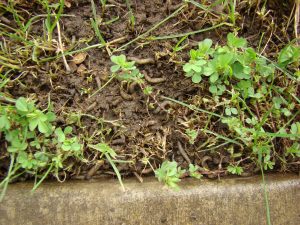Brown and bare spots on lawns in western Oregon – some spanning large areas – are the result of a heavier-than-usual crane fly outbreak.
“Some years are worse than others for crane fly infestations,” said Alec Kowalewski, turfgrass specialist for Oregon State University Extension Service. “Because of the especially wet fall and spring, they are bad this year.”
On the OSU campus, the damage is obvious in several areas. In one, the European crane flies migrated to the sidewalk and died – probably because they wanted to escape the overly wet soil and couldn’t find their way back, said Brian McDonald, senior research assistant in the turfgrass program. If you discover the same thing, he recommends blowing them into piles and using a shovel to scoop them up.

“They will die soon so there’s no need to spray,” McDonald said. “But I would dispose of them because they’ll begin smelling really bad once they’re dead.”
Short-lived adult European crane flies – people often call them mosquito eaters, though they aren’t – emerge in August to lay eggs in lawn. The eggs hatch into the wormlike larvae or “leatherjackets,” which feed on the roots and crowns of the grass in late fall and early spring.
“To repair from the damage these insects have caused, the best thing to do is to start building your lawn back up with seed and fertilizer,” Kowalewski said. “Proper mowing, fertilization and irrigation will increase your lawn’s tolerance to the pest, preventing visible damage in the future even when pest populations are relatively high.”
Now through Memorial Day is the optimum time to broadcast seed over the bare spots. Fertilize four to six times a year in spring and fall. For additional information on how to care for your lawn, refer to Extension’s publication Practical Lawn Care for Western Oregon.
“The damage has already been done and insecticide effectiveness will be minimal on the mature insect larvae that you see now,” Kowalewski explained. “Instead wait until October and start monitoring your lawn to see if you have a sufficient number to warrant spraying.”
To check for an infestation next fall, dig up a 1-square-foot area of lawn about three inches deep and count the crane fly larvae. If there are 25 to 50 insects, you’ll want to start a control program. They’ll be small and harder to see than at this time of year, but easier to kill.

Turning off irrigation around Labor Day will help keep populations to a minimum because that’s when the adults lay eggs in moist soils.
If you decide to use an insecticide, look for one containing bifenthrin as the active ingredient, Kowalewski said. Bifenthrin is toxic to bees, so apply in evening, night or early morning when fewer bees are foraging. As always, read and follow all the safety instructions.
If you want an organic treatment, try an insecticide made of pyrethrins. Look for those with OMRI certification. Beneficial nematodes can also be used, but research has shown they only work on about 50 percent of larvae. In some cases, that could be effective if you follow up with appropriate lawn care. For more information, on crane flies and their control, see an Ask an Expert answer and a fact sheet in the Pacific Northwest Pest Management Handbook.

